|
How they will improve receiver performance.
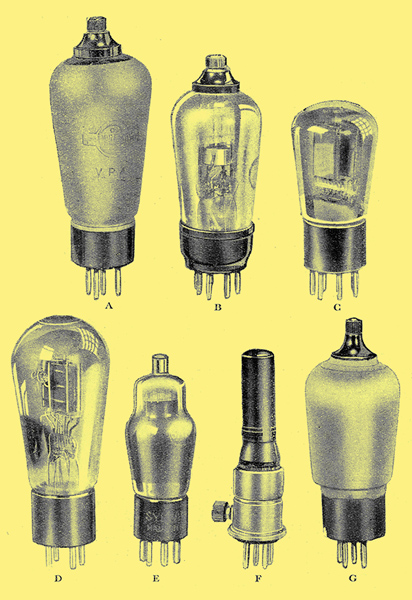
Typical new valves: (A) Mullard VP4, a variable-μ screened HF pentode; (B) Marconi double - diode triode, MHD4; (C) Mullard PM2B, twin Class B output valve; (D) Tungsram PX46 single Class B valve, two of which will give 21 Watts speech output; (E) Sylvania 6A7 Pentagrid; (F) Marconi Catkin pentode MPT4; (G) Tungsram SE2018 variable-μ AC/DC valve.
Never before has the amateur been afforded so large a choice of valves. Every type of receiver and every stage in the receiver is now provided with a specialised type; in a word, this is the era of valve specialisation and the all-purpose valve becomes the exception rather than the rule. In order to conserve space in the receiver many manufacturers are adopting the expedient of putting the elements of two valves into one bulb - a practice which, if not carried too far, makes for economy and greater efficiency.
It is the purpose of this article to explain why the new valves have been introduced and to give a brief account of the improvement in performance which may be expected when they are made to replace earlier types. The first series to be dealt with are the HF pentodes. In the ordinary three-electrode valve, in which the anode is held at a comparatively high positive potential, electrons are shot off at high speed from the hot filament, and those which bombard the anode at the highest velocity are capable of dislodging other electrons known as secondary electrons. These eventually find their way back to the anode and the functioning of the valve suffers no detriment. When, however, a second electrode at a high positive potential is added, as is the case in the ordinary screen-grid valve and the variable-μ tetrode, it is just possible that some of these electrons may be attracted to the extra electrode or screening grid, as it is called, especially it the latter happens to be at a more positive potential than the anode. Thus there occurs the peculiar phenomenon that at certain anode voltages the screening grid may rob the anode of current and for a short distance along the characteristic curve an increase of anode volts is accompanied by a decrease of anode current.
This rather startling effect is just the opposite to that produced by a resistance, and so is called negative resistance; the effect of it is to cause a receiver in which the valve is included to oscillate uncontrollably.
Every effort is made to prevent this state of affairs by applying to all screen-grid valves a screen voltage which is roughly half that of the anode voltage, but it must be remembered that as far as signal potentials are concerned the screening grid is tied down to earth and so has a fixed potential, whilst for the process of amplification the anode voltage must rise and fall in sympathy with the signal above and below the fixed voltage. Until recently the screen-grid and variable-μ valves available gave ample margin of safety, but with the advent of automatic volume control and diode detection demanding, as they do, very large signal voltages, the negative resistance portion of the curve is often encroached upon, momentarily causing HF distortion.
HF Pentodes

The obvious remedy is to remove, if possible, the negative resistance effect of the SG valve. Fortunately, this can be done fairly easily by adding an electrode between the screening grid and anode and attaching it to the cathode in other words, by making the tetrode into a pentode. The secondary electrons now find a barrier which prevents access to the screening grid and larger signal potentials can be handled with impunity.
The screened HF pentode with both ordinary and variable-μ characteristics is likely to be marketed by all the leading valve manufacturers before the Olympia Exhibition, and it is fairly safe to prophesy that it will supersede the SG valve and variable-μ tetrode. At present there are on the market one Ferranti and two Mullard models, shown in the tables which accompany this article. Apart from the advantage already described, namely, the capacity to handle very large signals without distortion, it is found that the screening-grid voltage is not nearly so critical as it is with the ordinary SG valve and less complicated resistance networks are needed. It is anticipated that HF pentodes will appear with screening grids capable of carrying the full anode voltage so that the feed network may be omitted altogether. This would lead to considerable economy of components in the HF stages.
High-frequency pentodes are at present marketed with 5-pin bases (the anode connection being at the top of the bulb) so that any variable-μ or ordinary SG valve can be readily replaced without alteration of wiring, but as soon as the standard 7-pin base is used it is hoped that the suppressor grid now taken internally to the cathode will be brought out to one of the idle pins. We should then have a ready means of injecting volts from the oscillator valve into the HF pentode first detector. Also it has been found that when negative bias is applied to the suppressor grid the valve's AC resistance drops, thus causing damping of the associated tuned circuit and providing a method of reducing sideband cutting with the local station. The second idle pin could be connected to the metal covering of the bulb, since a cathode-connected screen in a single-valve frequency changer for instance - for which purpose the HF pentode can be used - is not desirable, as it is well above earth potential. The Mullard SP4 has been tried as a power grid detector in a straight set, and it was found to be more sensitive in this position than any SG valve.
The next series of valves to be discussed is the multiple type, including a single or double diode. Every constructor must have experienced the overloading of a grid detector in a set with reaction control. As reaction is increased the signal strength grows to a maximum and then drops quite a lot before oscillation starts. The effect is due to detector overload, and can be ascribed to the fact that in a grid detector the signal is rectified in the grid circuit and then amplified in the anode circuit, the latter having to accept the HF plus the LF component. Anode bend rectification in opposite phase to grid rectification readily occurs with large inputs, and the output is not only restricted but distorted. Now that AVC has come to stay in this country, the death of the power grid detector for superhets. and straight sets with 2 HF stages embodying this system is a foregone conclusion. Large control voltages tor the early valves in the receiver are required and can best be supplied by a diode which will rectify a signal of 50 Volts or more without any signs of overloading. Furthermore, the diode detector for reasonably large signals is nearly 100% efficient and distortionless.
The Double-diode Series
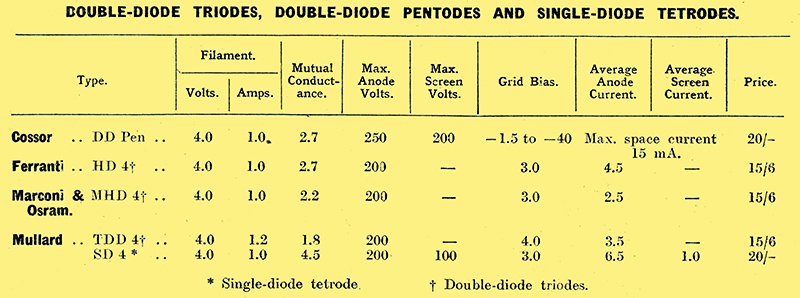
By mounting a triode in the same bulb as the diode, economy of space is effected, and if an HF filter. is interposed so that the triode grid receives only LF impulses, the output is considerably greater than it would be were the same valve to be fully loaded as a grid detector. In fact, the Marconi and Osram MHD4 will fully load a PX4 output valve using resistance coupling. There is another great advantage in using a diode detector; the damping of the preceding tuned circuit is very small indeed, and may be five or six times less than with the conventional grid detector.
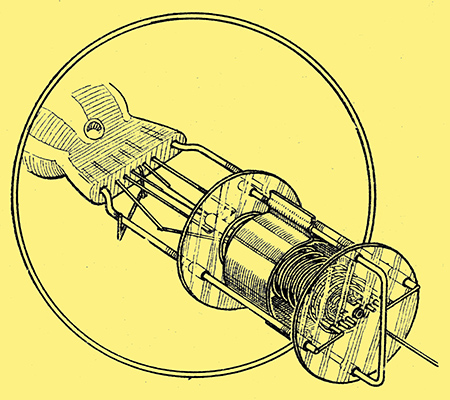
The electrode construction of a multiple diode valve for corrected AVC - the Cossor DDPen.
Of the multiple valves of this type the most popular is the double-diode triode now introduced by Marconi and Osram, Ferranti and Mullard. The first diode anode is used for half-wave detection, while the second is arranged to give delayed AVC.The single-diode tetrode (the Mullard SD4) cannot, of course, be used for delayed AVC, but it is a good detector followed by a highly sensitive tetrode for true LF amplification. Using resistance coupling, a large output valve can be satisfactorily loaded. In the Cossor double-diode pentode (DDPen) the automatic volume control voltage is not only taken back to the HF and IF valves, but also forwards to the variable-μ grid of the pentode forming part of the multiple valve. By this means almost perfect AVC is obtained. For a change of input over a quarter of a million to one the output only alters by 10% a performance which is much in advance of other methods.
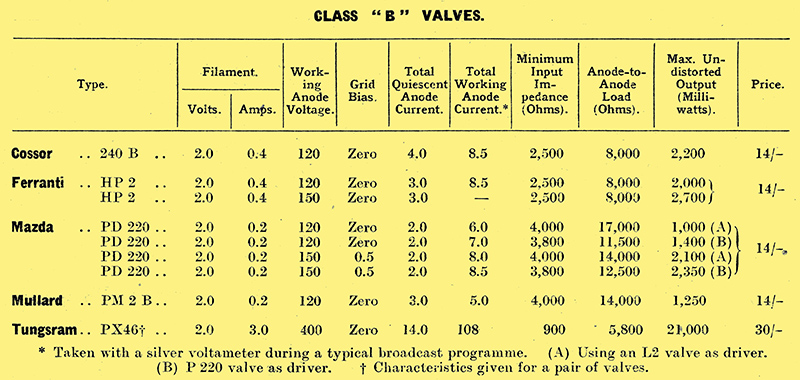
Class B valves have had so much space devoted to them lately that little need be said here. The battery set user can now obtain about seven times the Watts output that he could extract from his single triode output valve for an HT battery consumption which is hardly increased. It is confidently expected that nearly all the coming season's battery sets will be equipped with Class B output. An obvious development in this field is Class B valves for DC mains where there is perforce a limited anode voltage. For very large volume with AC mains sets class B output can show considerable economy. Two Tungsram PX46 valves (see table) used in positive drive will give the enormous output of 21 Watts speech.
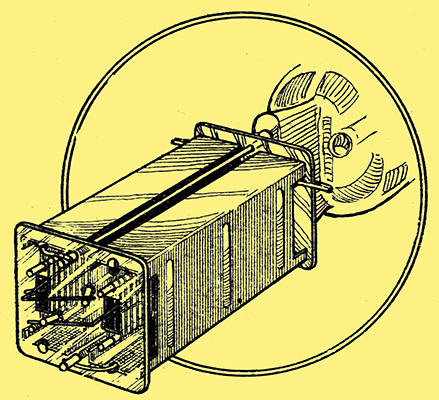
The double-triode assembly of the Ferranti Class B valve - the HP2.
The Pentagrid

A new single-valve frequency changer known as the Pentagrid, which hails from America, has lately made its appearance here. From preliminary experiments in The Wireless World laboratory it is fairly safe to predict that it will find wide application in superhets. It has distinct advantages over the hexode now popular on the Continent, since by virtue of an extra screen within the valve it does not require an external balancing circuit. Within the Pentagrid are the elements of a triode oscillator and variable-μ screen-grid first detector with sufficiently large grid base to allow of full AVC control. The mixing is electronic in nature and the screening between elements so effective that there is no interaction between tuned circuits and no aerial radiation even when an HF stage is not used. Due to the avoidance of first detector harmonics, whistles are conspicuous by their absence and the efficiency of the new arrangement, judged by the increased output, is greater by two or three times than any other single-valve changer and is a distinct improvement over the conventional two-valve scheme with separate oscillator.
Valves for AC-DC and Car Radio

A range of AC/DC valves with 20 Volt 0.18 Amp heaters has been introduced by Tungsram for sets which can be operated on any mains supply irrespective of voltage or frequency. No mains transformer is required, and the half-wave mains rectifier contains a 20 Volt heater connected in series with the heaters of the receiving valves. When this arrangement is used on DC supplies the rectifier becomes a passenger and acts simply as a resistance dropping only 15 Volts.
No review of new valves would be complete without mention of the all-metal Catkins which, although they do not introduce new electrical characteristics, are of fundamentally new construction and are destined to cause an entire revision of ideas in valve design.
Valves likely to be introduced in the near future are a series of indirectly heated types for car radio and a new design for providing AVC in battery sets.
|